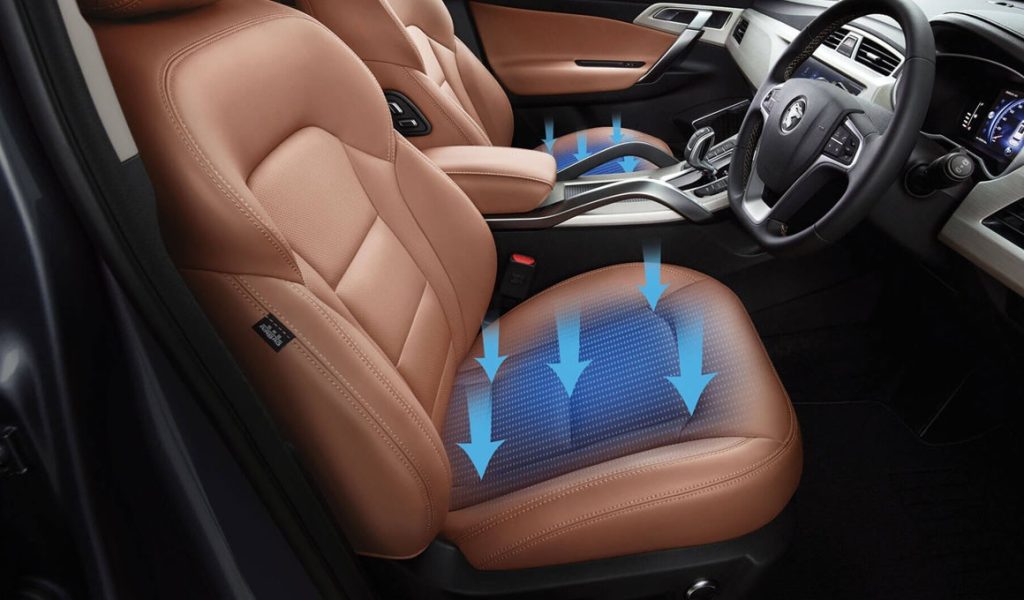In today’s fast-paced world, comfort is key, especially when it comes to spending time in our vehicles. As technology continues to evolve, so do the features available in cars, and one such feature gaining popularity is ventilated seats. But what exactly are ventilated seats, and why are they becoming a sought-after option in vehicles? Let’s delve into the world of ventilated seats to uncover the answers.
Understanding Ventilated Seats
Ventilated seats, also known as cooled seats, are a feature commonly found in modern vehicles. Unlike traditional seats, which rely solely on heating elements to provide warmth during cold weather, ventilated seats incorporate fans and air vents to circulate air through the seat cushion and backrest, providing a cooling effect to the occupants.
How Do Ventilated Seats Work?
At first glance, ventilated seats may seem like a complex system, but their operation is relatively simple. Small fans located within the seat draw in air from the vehicle’s interior and pass it through perforations in the seat surface. As the air flows through the perforations, it helps to dissipate heat and moisture, keeping the occupants feeling cool and comfortable, even on hot summer days.
The Benefits of Ventilated Seats
- Enhanced Comfort: Ventilated seats help prevent discomfort and sweat buildup, especially during long drives or in hot weather conditions. The airflow provided by ventilated seats promotes better ventilation and reduces the likelihood of feeling sticky or clammy during extended periods of sitting.
- Improved Air Circulation: By promoting airflow, ventilated seats contribute to better ventilation within the vehicle, ensuring a more pleasant driving experience for everyone. This improved air circulation not only benefits the occupants seated in the ventilated seats but also helps maintain a consistent temperature throughout the vehicle’s interior.
- Temperature Regulation: Whether it’s scorching heat or humidity, ventilated seats provide relief by maintaining a comfortable temperature level. The airflow created by ventilated seats helps to dissipate heat and moisture, preventing the seats from becoming too hot and sticky, even on the hottest of days.
- Health Benefits: Ventilated seats can help reduce the risk of heat-related health issues such as heat exhaustion and dehydration, particularly during extended periods of sitting in the car. By keeping the body cool and comfortable, ventilated seats contribute to overall well-being and driver alertness during long journeys.
Why Ventilated Seats Are Gaining Popularity
In recent years, there has been a surge in demand for vehicles equipped with ventilated seats, and several factors contribute to their rising popularity.
Increasing Focus on Comfort
As consumers prioritize comfort and convenience in their vehicles, automakers are continually introducing innovative features to cater to these demands. Ventilated seats offer a luxurious touch, elevating the driving experience and setting certain vehicle models apart from the competition. In an increasingly competitive market, automakers are turning to features like ventilated seats to attract discerning consumers seeking ultimate comfort.
Climate Control Considerations
With climate change leading to more extreme weather conditions in many regions, the ability to maintain a comfortable interior temperature has become increasingly important for drivers and passengers alike. Ventilated seats provide an effective solution for combating heat and humidity, ensuring a pleasant environment inside the vehicle regardless of the weather outside. Whether it’s a scorching summer day or a muggy afternoon, ventilated seats offer respite from the elements, allowing occupants to enjoy a comfortable ride no matter the conditions.
Technological Advancements
Advancements in automotive technology have made it easier and more cost-effective for automakers to incorporate features like ventilated seats into their vehicles. As these technologies become more accessible, they trickle down from high-end luxury models to mainstream vehicles, making them accessible to a broader range of consumers. In addition to ventilated seats, advancements in automotive technology have led to the integration of other comfort and convenience features, further enhancing the driving experience for consumers.
The Future of Ventilated Seats
As automotive technology continues to evolve, we can expect to see further improvements and innovations in the realm of ventilated seats. Manufacturers may explore options such as integrating smart sensors to automatically adjust airflow based on occupants’ preferences or incorporating additional comfort features to enhance the overall driving experience. In addition to improving comfort, future iterations of ventilated seats may focus on energy efficiency and sustainability, aligning with broader industry trends towards eco-friendly transportation solutions. (See Also: Car Headliner Alternatives: Creative Solutions for Interior Excellence)
Expert Tips for Maximizing Comfort with Ventilated Seats
When it comes to enjoying the benefits of ventilated seats to the fullest, a few expert tips can make all the difference. Let’s explore some practical advice for maximizing comfort during your time behind the wheel.
Understanding Seat Settings
Before hitting the road, take the time to familiarize yourself with the various settings and controls for your ventilated seats. Adjust the airflow and intensity levels to suit your preferences and the current weather conditions. Experimenting with different settings can help you find the perfect balance of comfort and cooling.
Regular Maintenance and Cleaning
To ensure optimal performance and longevity, it’s essential to keep your ventilated seats clean and well-maintained. Regularly vacuuming and wiping down the seat surfaces can help prevent debris and dirt from clogging the ventilation channels. Additionally, consider using a specialized upholstery cleaner to remove any stains or spills promptly.
Dress Appropriately
While ventilated seats provide cooling relief, your choice of clothing can also impact your comfort level. Opt for lightweight and breathable fabrics that allow air to circulate freely, enhancing the effectiveness of the ventilated seats. Avoid wearing heavy or restrictive clothing that may inhibit airflow and trap heat against your body.
Use in Conjunction with Air Conditioning
For maximum comfort on hot days, consider using your ventilated seats in conjunction with the vehicle’s air conditioning system. By combining airflow from the ventilated seats with cool air from the AC vents, you can create a refreshing oasis inside your vehicle, even when temperatures soar outside. Experiment with different temperature settings to find the ideal balance for your comfort.
Take Breaks When Needed
While ventilated seats can help keep you cool and comfortable during long drives, it’s essential to listen to your body and take breaks as needed. Stretch your legs, hydrate, and step outside for some fresh air to prevent fatigue and maintain alertness behind the wheel. Remember that comfort and safety go hand in hand, so prioritize your well-being during extended periods of driving.
By incorporating these expert tips into your driving routine, you can make the most of the comfort-enhancing benefits of ventilated seats. Whether you’re navigating busy city streets or embarking on a cross-country road trip, a little attention to detail can go a long way towards ensuring a pleasant and enjoyable driving experience. (See Also: Hard Top vs. Soft Top Jeep: Unraveling the Best Choice for Your Ride)
Frequently Asked Questions About Ventilated Seats
As ventilated seats continue to gain popularity among vehicle owners seeking enhanced comfort and climate control, it’s natural to have questions about this innovative feature. Let’s address some common inquiries to help you better understand ventilated seats and their benefits.
What are ventilated seats?
Ventilated seats, also known as cooled seats, are a feature found in many modern vehicles. Unlike traditional seats that rely solely on heating elements, ventilated seats incorporate fans and air vents to circulate air through the seat cushion and backrest, providing a cooling effect to occupants.
How do ventilated seats work?
Ventilated seats work by drawing in air from the vehicle’s interior through small fans located within the seat. This air is then circulated through perforations in the seat surface, helping to dissipate heat and moisture and keeping occupants feeling cool and comfortable, even on hot days.
Are ventilated seats only useful in hot weather?
While ventilated seats are particularly beneficial in hot weather, they can also provide comfort in various climate conditions. In addition to cooling, ventilated seats can help prevent sweat buildup and discomfort during long drives or in humid environments.
Do ventilated seats consume a lot of energy?
Most ventilated seat systems are designed to be energy-efficient, utilizing low-power fans to circulate air without placing a significant strain on the vehicle’s electrical system. Additionally, many modern vehicles feature smart climate control systems that optimize energy usage for maximum efficiency.
Can I retrofit ventilated seats into my current vehicle?
In some cases, it may be possible to retrofit ventilated seats into a vehicle that did not originally come equipped with this feature. However, retrofitting can be complex and may require modifications to the seat structure and electrical system. It’s recommended to consult with a professional automotive technician or upholstery specialist for guidance.
Are ventilated seats compatible with seat covers?
While ventilated seats can still provide some cooling benefits when used with seat covers, the effectiveness may be reduced depending on the material and thickness of the cover. It’s best to choose breathable and lightweight seat covers that allow airflow to pass through easily for optimal comfort. (See Also: Leather vs Leatherette Car Seats: Choosing the Best Upholstery for Your Ride)
Can ventilated seats help alleviate back sweat?
Yes, ventilated seats can help reduce back sweat by promoting airflow and moisture evaporation. The circulating air helps to keep the seat surface dry and comfortable, minimizing the discomfort associated with sweat buildup during extended periods of sitting.
Are ventilated seats safe for children and pets?
Ventilated seats are generally safe for passengers of all ages, including children and pets. However, it’s essential to use caution and avoid leaving children or pets unattended in a vehicle, especially in hot weather. Additionally, always follow the manufacturer’s guidelines and recommendations regarding the use of ventilated seats.
Do ventilated seats require special maintenance?
While ventilated seats do not typically require extensive maintenance, it’s essential to keep them clean and free of debris to ensure optimal performance. Regular vacuuming and wiping down the seat surfaces can help prevent dirt and dust from clogging the ventilation channels. Additionally, consider using a specialized upholstery cleaner to remove any stains or spills promptly.
Conclusion
In conclusion, ventilated seats represent a significant advancement in automotive comfort and climate control technology. With their ability to provide cooling relief and enhance overall comfort, it’s no wonder why they’re becoming a must-have feature in modern vehicles. Whether you’re embarking on a long road trip or simply running errands around town, ventilated seats ensure that you arrive at your destination feeling cool, refreshed, and ready for whatever the journey may bring. As consumer preferences continue to evolve, we can expect to see continued innovation in automotive comfort features, with ventilated seats playing a central role in shaping the future of the driving experience.



